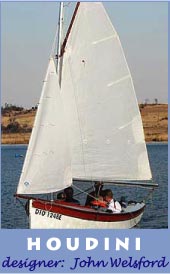
 Custom Search
|
| boat plans |
| canoe/kayak |
| electrical |
| epoxy/supplies |
| fasteners |
| gear |
| gift certificates |
| hardware |
| hatches/deckplates |
| media |
| paint/varnish |
| rope/line |
| rowing/sculling |
| sailmaking |
| sails |
| tools |
| join |
| home |
| indexes |
| classifieds |
| calendar |
| archives |
| about |
| links |
| Join Duckworks Get free newsletter CLICK HERE |
|
|
| Two is the Magic Number |
by Bruce Bateau - Portland, Oregon - USA |
"I've never seen more than two human powered craft on the Lower Columbia River at any given time," my friend Neil said with a touch of sadness. "How can that be? It's so close to Portland," I pondered aloud. "You can hardly walk down the street here without seeing a kayak strapped to the roof of a car." Neil just shrugged before adding, "maybe it's something about the current." True, the current runs swiftly towards the sea for a good portion of the year. It goes from a half a knot on up, but with towering cliffs, volcano views, and lots of room to sail without tacking, I find myself there frequently. And as Neil observed, I'm often the sole motorless boat, unless I bring a friend. Last weekend was no exception, it was just me in Row Bird, my 18 foot sail and oar boat, along with 500 over-powered aluminum fishing boats, known locally as jet sleds. Unbeknownst to me, it was the peak of the salmon run. The fishers weren't catching much, so a lot of them were in constant motion while they searched for just the right spot. This created a jumbled mess of wakes and ripples from the river and changing tide (the Columbia is tidal for nearly a hundred miles inland) all moving in different directions at different times. I'd been watching the river's local weather station online before I left home and it looked like there was wind, but when I arrived, not a leaf was stirring. It was a shaping up to be a pleasant spring morning, so I decided to row upstream.
Once I was on the water however, I found that the rumble of boat motors, the occasional roar of a jet landing at the nearby airport and the clattering of freight trains on the opposite shore made for an audio assault. I considered myself to be in training for combat rowing. My missions: Watch out for flying lures. Defend against jet sleds who don't know the rules of the road. Avoid dead heads and rotting, half submerged pier pilings. Stay dry and upright. And above all: Have fun. Wakes hit my hull and splashed onto the deck. Row Bird shifted so frequently from the chop that my hips resembled a hula dancer's. While no one was aggressive towards me, as the lone rower I got a lot of curious stares. After working the oars for nearly two hours without a break, I'd made it a few miles upstream. Still there was no sign of wind so I decided to eat lunch and let the current pull me back to the ramp. If the wind filled in, I'd sail for a while. If not, I'd head for home. As I approached the dock a tickle of wind appeared and ripples whisked along the river. I hoisted sail and headed back upriver, easily covering the ground it took me two hours to row in 45 minutes. The jet sleds were completely discouraged by now and started peeling off towards the dock. Soon I had the river mostly to myself. Gliding by points I struggled to row past earlier, I felt powerful and laughed loudly. Though gleeful, I wished there were some other small boat sailors to share the wind and the beautiful day. When I got back to my trailer hours later, I thought of Neil. In the parking lot stood two kayakers preparing to launch. Having three human powered craft on the river simultaneously would have broken his rule. I wished them luck. Bruce |
To comment on Duckworks articles, please visit one of the following:
|
 |





